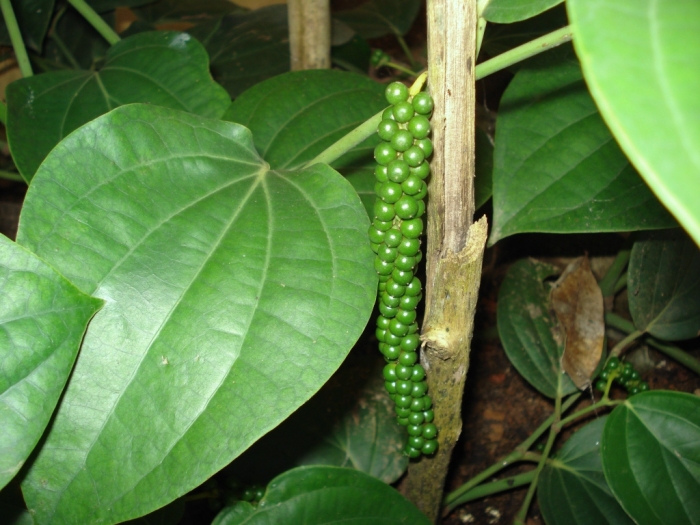Black Pepper
(Piper nigrum)
Black Pepper (Piper nigrum)
/
/

Aruna Wikipedia
CC BY-SA 3.0
Image By:
Aruna Wikipedia
Recorded By:
Copyright:
CC BY-SA 3.0
Copyright Notice:
Photo by: Aruna Wikipedia | License Type: CC BY-SA 3.0 | License URL: https://creativecommons.org/licenses/by-sa/3.0 | Uploader: AG47 | Publisher: Wikimedia Commons | Title: TVM_Pepper.JPG | Notes: {{Information |Description={{en|1=Leaves of a {{w|pistachio}} tree in {{w|Syria}}.}} {{fr|1=Feuilles de [[:fr:Pistachier vrai|pistachier vrai]] en [[:fr:Syrie|Syrie]].}} |Source={{own}} |Author={{User:Eusebius/Credits|cam=450D|cat=syria}} |Date=2010-04-14 |






























Estimated Native Range
Summary
Piper nigrum, commonly known as Black Pepper, is a perennial woody vine that is cultivated primarily for its fruit, which is dried and used globally as a spice and seasoning. Black Pepper is native to the Western Ghats of India, thriving in the dense, humid, evergreen and deciduous forests as well as the sunny regions with dappled shade. The plant can grow up to 4 meters (13 feet) in height on supporting trees, poles, or trellises, and it is characterized by its heart-shaped leaves and small, white flowers that develop into the well-known peppercorns.
Black Pepper is valued for its peppercorns, which are harvested before full maturity to maintain their pungency. The vine is beneficial for its high yield of peppercorns, which are a staple in cuisines worldwide. It is also used in traditional medicine for its potential health benefits. In cultivation, Black Pepper is often grown in tropical gardens and greenhouses, where conditions mimic its native habitat. It requires moist, well-drained soil rich in organic matter, and although it can tolerate a range of soil drainage speeds, it does not thrive at altitudes above 900 meters (3,000 feet). Regular watering is crucial during the dry season for the first three years. The vines start bearing fruit from the fourth or fifth year and can continue to be productive for seven years. Black Pepper prefers part shade but can also grow in full sun if the climate is not too hot.CC BY-SA 4.0
Black Pepper is valued for its peppercorns, which are harvested before full maturity to maintain their pungency. The vine is beneficial for its high yield of peppercorns, which are a staple in cuisines worldwide. It is also used in traditional medicine for its potential health benefits. In cultivation, Black Pepper is often grown in tropical gardens and greenhouses, where conditions mimic its native habitat. It requires moist, well-drained soil rich in organic matter, and although it can tolerate a range of soil drainage speeds, it does not thrive at altitudes above 900 meters (3,000 feet). Regular watering is crucial during the dry season for the first three years. The vines start bearing fruit from the fourth or fifth year and can continue to be productive for seven years. Black Pepper prefers part shade but can also grow in full sun if the climate is not too hot.CC BY-SA 4.0
Plant Description
- Plant Type: Vine
- Height: 10-15 feet
- Width: 10-15 feet
- Growth Rate: Rapid
- Flower Color: N/A
- Flowering Season: Summer
- Leaf Retention: Evergreen
Growth Requirements
- Sun: Part Shade
- Water: Medium
- Drainage: Slow, Medium, Fast
Common Uses
Edible*Disclaimer: Easyscape's listed plant edibility is for informational use. Always verify the safety and proper identification of any plant before consumption.
Natural Habitat
Native to the dense, humid, evergreen and deciduous forests of the Western Ghats of India, as well as sunny regions with dappled shade
Other Names
Common Names: Pepper, White Pepper, Pfeffer, Pimienta, Poivre, Poivre Blanc, Poivre Noir, Pepe, Pimenta, Pimenta Do Reino
Scientific Names: , Piper nigrum, Piper denudatum, Piper malabarense, Piper nigricans, Muldera multinervis, Piper aromaticum, Piper baccatum, Piper colonum, Piper glyphicum
GBIF Accepted Name: Piper nigrum L.